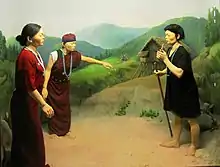Tagin people
The Tagin are one of the major tribes of Arunachal Pradesh, a member of the larger designation of Tani Tribes.Tagins are known for their warm hospitality and are considered very friendly in nature and also pure hearted.
 Tagin Diorama | |
| Total population | |
|---|---|
| 62,931 approx. (2011)[1] | |
| Regions with significant populations | |
| Arunachal Pradesh | |
| Languages | |
| Tagin language | |
| Religion | |
| Donyi-Polo and Christianity | |
| Related ethnic groups | |
| Nyishi, Apatani, other Tani Tribes |
Location
Tagins are the dominant tribe in Upper Subansiri district.[2] They are also found dispersed in the adjoining districts, especially in West Siang, Papum Pare, in Arunachal Pradesh, as well as some areas of Tibet adjacent to Arunachal Pradesh. Since China took away some of the Arunchal area after the 1962 Sino-Indian War, there are Tagins present in Tibet who are included under Lhoba people.
Population
According to 2011 census there are 68,534 Tagin people in India. A few thousand in Tibet is expected. There are many clans among the Tagins such as the following: Tamin (Nakam, Nayam, Neva, Negia Nutik, Mindi (Nasi & Nalo) and Japo), Leyu, Reri, Natam-Gyadu (Bagang), Nah, Gyama, Tache-Tagia, Tasi, Topo, Tani-Tator, Cherom-Chera, Buning, Heche, Kodak-Konia, Nalo, Pombu, Bagang (Nacho, Naji, Singming etc), Aiyeng (Payeng), Paji, Gumsing, Kojum abu and many more.
Language
Tagin people speak their own local dialect which is Tagin. Although there are tonal variations among them, these variations causes no hurdle in understanding each other.
Religion
Originally the traditional Donyi-Poloism as a religion was being followed all around. Which follows the cult of animism and ritualistic nature worshiping in the form of spiritual deities where particular kind of animals or bird are sacrificed at the altar (Nyúgè-made out of the bamboos and woods with particular leaves or vines in stuffed shape) to please the spirits, more likely not anger them and keep them in their kind form. Priest or Nyibu shaman who are born with their powers are the ones who communicate and negotiate between the other world. They are the in between messenger from this world to other world.
Recent years have seen mass conversions among members of the local community into Christianity, which has intensified Western influx in the culture, with more and more of the people embracing Western culture. This has led them to leave their tradition and culture, even the dialect.
Festivals
The most important festival of the Tagins is the Si-Donyi Festival, which involves the veneration of the earth (si) and the sun (donyi).[3] Si-Donyi is celebrated from 3 to 6 January every year. It is celebrated as a new year where the nyibu (local priest) presides over and performs all the rituals with chanting of Uuyu Benam (celestial chants). And sacrifice of Mithun (Gayal) for peace and prosperity in the community as a whole.
Organisations
Tagin Cultural Society (TCS) and Tagin Welfare Society (TWS) are the main parental organisation of the tribe. There are alsoyouth/student called All Tagin Students Union (ATSU) and All Tagin Youth Organisation (ATYO). The TWS or TCS also have many subgroups, and have been helping in shaping the future of the state.
References
- "Census of ST". Census 2011. MHA GOI.
- Upper Subansiri District Census Handbook, Part A (PDF), Directorate of Census Operations, Arunachal Pradesh, 2011, p. 27
- Mahendra Naran Karna (1998). Social Movements in North-East India. Indus Publishing. p. 64. ISBN 81-212-0334-1.
Bibliography
- Upper Subansiri District Census Handbook, Part A (PDF), Directorate of Census Operations, Arunachal Pradesh, 2011
- Krishnatry, S. M. (2005), Border Tagins of Arunachal Pradesh: Unarmed Expedition 1956, National Book Trust, ISBN 978-81-237-4460-5